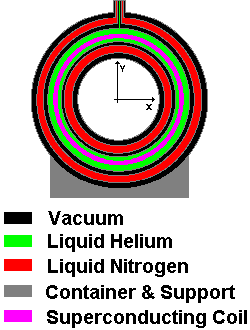The Components of a MRI Scanning Machine.
In order for the scanning machine to produce an image, there must be a constant magnetic field, a changing magnetic field, radio frequency waves, and a computer to interpret the results.
Constant Magnetic Field
The constant magnetic field (Bo) is usually produced by a super conducting magnet. A super conducting magnet is a tightly wound wire through which an electric current is passed, resulting in a uniform static magnetic field. Producing a current takes a whole lot of voltage and in order to conserve, the wire is kept at -452.4 degrees below zero with liquid helium and nitrogen. This causes the resistance in the wire to be nearly equal to zero, which means it takes less voltage to produce the needed current (V=IR).

This is a cross-sectional view of a common super conducting magnet. The main component is the super conducting coil or wire that produces the magnetic field. In order to save energy, the vacuums and liquid nitrogen and helium are used.
Changing Magnetic Field
The changing magnetic field is produced by three variable gradient magnets, one to alter each of the magnetic fields along the three-dimensional coordinate system (x, y, z).
the positive z direction and the gradient magnets are along the x, y, and z axes.
Here the direction of the main (constant) magnetic field is in

If this were an atom, the three planes would be the gradient magnets and would rotate about each axis. For instance, the sagittal plane (yz-plane) would rotate about the sagittal axis (y-axis). In this way each point in the atom is looked at from every possible angle.
Radio frequency waves
Radio frequency (RF) waves are pulses of energy that interact with the atoms in the sample (hydrogen atoms for our purposes). By examining how the RF waves interact with the atoms, we can essentially produce a picture. RF waves are applied to the subject and received from the subject using RF coils.


These two types of coils are commonly used in MRI machines because they produce homogenous RF waves.
Computers
The computer interprets the interaction between the RF waves, which pulsate energy, and the matter being studied.
This photo shows a MRI scan in progress.
As you can see, the computer does all of the tedious work while the technician pays attention to the generated image.
Now, we make use of the physics behind these components to produce an image!!